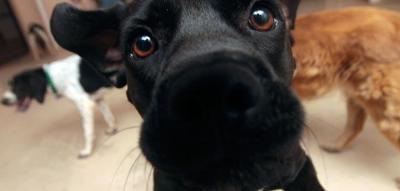
Dog Chasing Cat: How to Stop This Behavior
Chasing is a natural behavior for a dog, but when dogs chase cats in the home this behavior must be addressed. It can be stressful and even dangerous for a cat. However, it is still possible for dogs and cats to successfully coexist in the home. The following guidelines can help you stop a dog from chasing a cat through management (preventing the problem) and training (motivating the dog to change the behavior).
How to stop a dog from chasing a cat
Cat-chasing is a self-reinforcing behavior — the more the cat runs, the more the dog will want to chase. Prevention of inappropriate behavior is important by properly introducing dogs to cats.
If at any time during the introduction process the dog barks, fixates on the cat, or tries to chase the cat, remove the dog from the situation so they cannot continue practicing inappropriate behavior. This also works with a dog who already has a tendency to chase the cat. Have a quiet area ready where you can take your dog — a crate or bathroom, for instance. It should be a place that your dog already associates with good things.
The instant your dog starts to behave inappropriately toward your cat (chasing the cat, whining, or simply becoming fixated), lead or lure the dog away from the cat to the quiet area. You should act calmly to avoid arousing the dog even more, and you should avoid speaking to your dog. After a minute or two, release your dog in an equally low-key manner. If the dog comes back and repeats the inappropriate behavior toward the cat, lead them back to the quiet area.
Home starts with you
Training a dog to get used to a cat
To increase the chances of success, reward your dog for desired behavior. Reinforcing appropriate behavior teaches your dog what you want them to do (i.e., be well-mannered around your cat). Prepare a supply of great-tasting training treats — small bits of whatever food your dog finds most enticing.
As soon as your dog looks away from the cat, praise them and offer a treat. Repeat every time your dog ignores the cat. Your dog will learn that whenever they see your cat, rewards are forthcoming from you if they look away from the cat. Essentially, you are training your dog to perform a certain behavior (looking away from the cat) upon seeing the cue (the cat). Just make sure the treats you are giving are more desirable to your dog than the fun of chasing the cat.
Once you’ve established what you want your dog to do (ignore the cat) and you’ve reinforced that behavior many times, you can choose to allow the dog more freedom around the cat. A reward-based training program such as this will teach your dog to listen to you and provide them with alternative behaviors to perform. Always be consistent in training and rewarding appropriate behavior.
Offering other outlets for your dog
If the chasing persists, the motivation for your dog could be boredom or lack of exercise. This can be physical exercise (e.g., running off-leash, playing with another dog friend, playing fetch with you, swimming) or mental exercise (e.g., learning basic cues and fun tricks, using food puzzles, learning nose work). A tired dog is a good dog, and tired dogs do much less chasing.
Also, provide a variety of appropriate chew toys. Some ideas for appealing chews are stuffed Kongs, pressed rawhide, and frozen broth. When you give your dog chew toys, make sure you offer them in a room away from the cat to prevent resource guarding.
Helping your cat be OK with a dog
At some point, you might need to help your cat change their association with your dog. Try feeding your cat tasty kitty treats while they're in the dog’s presence. During this exercise, make sure the dog can’t chase the cat.
Also, modify the environment so that your cat has a safety zone, a place that is inaccessible to your dog. Set up baby gates to create safe rooms, provide lots of high perches for your cat, and always supervise your dog when the cat is around.
